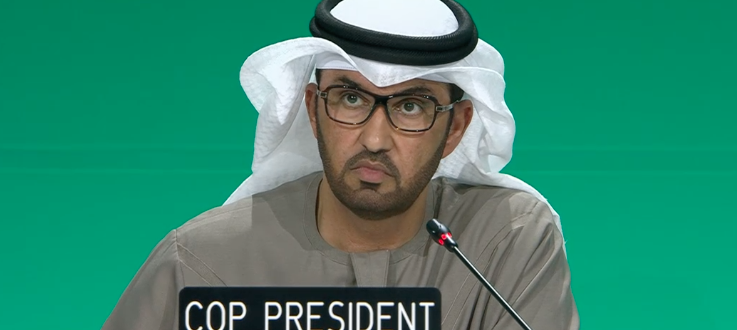GLOBAL GOAL ON ADAPTATION, BETWEEN LIGHTS AND SHADOWS TOWARDS ADOPTION AT COP28
- A ‘worrying’ gap on adaptation funding is recognised, between forecasts, commitments and actual transfers; but there are no constraints, only appeals
- Still optional in the text is the reference to the Paris Convention and Agreement, and also, where appropriate, the reference to common but differentiated responsibilities
- Targets are set for all countries to 2025, such as updated impact and risk assessments, and to 2027, such as the adoption of multi-hazard early warning systems
- Recognition of the fundamental role of indigenous peoples and local communities
The COP28 presidency is in a hurry. Work on the negotiating sessions is behind schedule, but President Sultan Al Jaber is in a hurry to close in time for the 12 December deadline. This is also why he convened an informal session on Saturday evening to take stock of the work and, above all, to close ranks.
On Sunday morning, in fact, the first draft decisions of some of the Contact Groups came out. Among these was the one relating to the GGA, the Global Goal on Adaptation, which is – as we read – a version of the ‘President’s text’, albeit, as specified in the notes, adopted in consultation with the presidents of the Subsidiary Bodies.
A text that, among the points that immediately catch the eye, highlights (art.25) “with concern that the gap in adaptation funding is widening” and reiterates the call and exhortation to developed countries to at least double their climate funding “for adaptation to developing countries from 2019 levels by 2025”.
In fact, as we know, this is precisely the key point for implementing adaptation policies and practices in developing or more vulnerable countries that need them immediately or in the near future. Activists, humanitarian organisations and civil society highlight all the critical issues with respect to the urgency to act on adaptation, the transfer of necessary funds and the non-compulsory transfer of funds. The crucial issue remains the rapid and effective bridging of this gap by developed countries, in line with their financial obligations under UN climate agreements.
Another controversial aspect, and one that evidently reflects the diversity of positions between the Parties to the negotiations, is that it is still unclear now whether the decision on the GGA will recall the Convention and the Paris Agreement itself (options 1 and 2, in the preamble) or even, if so, whether it will be ‘common but differentiated responsibilities’ (option 1). Or there will be no reference to them at all (option 3).
Among the positive aspects we would like to highlight are the targets (Art. 11) set for all countries to 2025, 2027 and 2030.
In the former, ‘up-to-date assessments of climate hazards, climate change impacts and exposure to risks and vulnerabilities and have used these assessments to inform the formulation of national adaptation plans and nationally determined contributions’.
By 2027, it is expected that ‘all Parties have established multi-hazard early warning systems and climate information services for risk reduction’.
Furthermore, by 2030, targets are set for planning (to 2025), implementation, monitoring and evaluation with regard to adaptation policies.
A work programme to further develop targets and indicators is also imposed. Targets are envisaged (but, not specific) on topics such as water, food, agriculture and health, resilience of ecosystems and infrastructure.
The text recognises the fundamental role of indigenous peoples and local communities regarding their values in developing the adaptation framework (Art.8); in protecting cultural heritage (Art.10.g); in defining indicators, metrics and targets in implementing adaptive action (Art.13); in implementing the overall adaptation framework (Art.19); and in recognising their leadership as custodians of nature (Art.21).
Negative aspects of the text remain, at the moment and from the currently published decisional draft, the absence of clear language on implementation and finance (beyond the doubling of the adaptation funding target).
In short, the picture is not yet clear. There are lights and shadows, but the key issue remains finance: its urgency and quantity. So that the instrument established in 2015 in Paris (COP21), carried forward in 2021 by the two-year programme established in Glasgow (COP26, CMA3) and with the framework launched in 2022 in Sharm el-Sheikh (COP27, CMA4) does not remain a beautiful theoretical initiative, devoid of concrete and real implications.
Here, we would like to see the bright lights of the pixels on the screens of the political decision-makers of the Developed Countries turned on sooner rather than later to press the ‘send’ button on the transfer of the necessary funds.
Article by Paolo Della Ventura, Italian Climate Network volunteer
Photo: (Sultan al Jaber, UNFCCC Platform)

